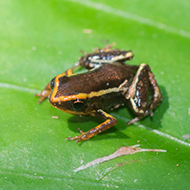
Findings could guide future conservation actions.
Smaller amphibians face a higher extinction risk because their females produce fewer offspring, according to new research.
The breakthrough study, published in the journal Global Ecology and Biogeography, suggests extinction risk increases in species that produce fewer young, such as rain frogs but decreases in species that produce more, such as bufonid toads.
Amphibians are the most endangered animals in the world. Currently, more than 40 per cent of amphibians, including frogs, toads, salamanders and newts, face being wiped out altogether.
It is a long-held belief that larger body size increases extinction risk – a theory derived from research on mammals. In this new study, researchers investigated, for the first time, whether it is not body size, but instead, the number of babies a female produces per clutch that determines extinction risk.
The team looked at amphibians from across the globe, including frogs, salamanders and caecilians, and matched the endangerment levels of thousands of species. They then analysed this information against their body sizes and the number of babies they produce per clutch.
Lead author Dr Daniel Pincheira-Donoso, a lecturer in Evolutionary Biology and Macroecology at Queens University Belfast, explains: “Our findings explain the discrepancies in the body size-extinction risk relationship observed between mammals and amphibians, given that larger mammals have fewer babies per birth and therefore extinction increases with larger body size, whereas in amphibians, larger females produce more babies, thus reducing extinction risk with larger body size.”
It is hoped the findings will guide future conservation action about which species and areas to protect - resetting the theory to focus on reproduction levels of animals rather than on body size when calculating extinction risk.
The study was a collaboration between Queens University Belfast, Nottingham Trent University, Tel Aviv University, Exeter University and the University of Lincoln.



 RCVS Knowledge has welcomed Professor Peter Cockcroft as editor-in-chief for Veterinary Evidence.
RCVS Knowledge has welcomed Professor Peter Cockcroft as editor-in-chief for Veterinary Evidence.